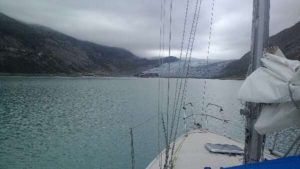We’re anchored in front of Reid Glacier this morning. The Inlet is large, much more than a mile long, which gives scale to things. A small dot in the distance is a 60-foot boat, which we learned was there on AIS.
We’ll dinghy over to the glacier later this morning and walk around.
Each morning has been overcast, but has burned off in the afternoon. For the cruise and tourist boats this hasn’t been the best. They arrive in the early morning and leave around noon. Yesterday, Eurodam, told us they saw neither of the two big glaciers because they were fogged in.
By the time we arrived at Johns Hopkins Glacier, around two pm, it was bright and sunny, but the two miles in front of the glacier were choked with small ice.
We have our trip track from 2016 loaded into OpenCPN on my laptop. We see that we were able to travel more than a mile and a half closer that year. The ice, then, was larger with more discrete pieces that we could thread our way through.
This year we went a short distance into the ice, but it was closing up behind us, meaning we might need to push our way through to get back out, something that is ill-advised in a fiberglass boat.
The Johns Hopkins Glacier looks like a large interstate highway with lanes that sweep from the right down to the water. Scale here is difficult to understand other that to try to keep in mind that it is filling your field of vision even though it is three miles away. Cruise ships become small against the glacial backgrounds.
Jennifer and Erwin struggled, using a collander, a bucket and scrub brush screwed onto the end of a boat hook, to gather glacial ice. The problems were manifold: Even the smallest pieces of ice were too large. We were ill-prepared in terms of tools, and Caro Babbo was too much free board. Laura and I would grab our partner by the belt to keep them aboard while they struggled, nearly upside down over the side of the boat, to land some ice.
They were successful. We have new ice in the ice box and Laura had glacial ice in her soda water at dinner.
This morning, we’ll load the Portland Pudgy with the four of us and motor over to the face of the Reid Glacier. In the afternoon, when the sky is clearing and the fog lifting, we’ll take Caro Babbo over to Margerie Glacier in Tarr Inlet. We’ll be back here in Reid Inlet for the night before moving on tomorrow.
The engine , once again, needs to be bled before starting. It was wonderful to just turn the key to start. Once back in Seattle, I’ll take one more pass at finding the problem, then I will fix the symptom.
The stove is working well… It was merely a fuel problem.
The water in Glacier Bay generally varies between rich blue and light turquoise. Near glaciers, the water changes with sharp demarcation between cafe au lait and cloudy turquoise because of the fine silt flowing off the glacier: we turn off the water maker to keep the filter and membrane from clogging. The filter is 30 micron; the silt flows easily through it.
It’s nice to be able to post using the Iridium. I hope everyone is enjoying the posts.
Don’t be afraid to contact us using the directions on the front page of the web site.
Best,
–j
Sent from Iridium Mail & Web.

